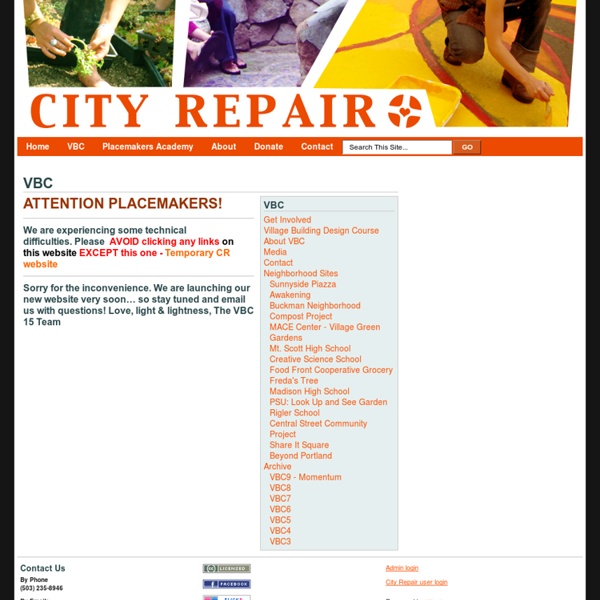



Next American City Sellwood Gap, one of the largest urban food forests in the USA. « Mark Lakeman.net The Sellwood Gap is a citizen-led initiative to transform a series of undeveloped lots into a reflection of the needs and desires of the Sellwood Neighborhood. This community is very fortunate to have access to this amount of open space since most Portland neighborhoods have been developed without provision for many kinds of common spaces. The land was acquired through a Metro Bond Measure which provides for a wide variety of possibilities including open space, wild life habitat and corridors, native plantings, edible landscapes, and other possible ideas. Like this: Like Loading... Give a Minute Project Jonathan Schultz Give a Minute homepage features a user interface modeled on Post-it notes. Courtesy Local Projects. One needn’t be a Walden-clutching Luddite to be wary of social media’s creep into the political process. “It doesn’t take a ton of insight to recognize that the existing public participation process does not really work well,” says Jake Barton, founder of Local Projects. His team responded with Give a Minute, a project that encourages urban citizens to organize and act to improve their blocks, stoops, playgrounds, even exercise routines, thereby drawing the attention — and financial support, where appropriate — of city officials. “In our current participation process, the powers that be plop down a plan in front of you,” Barton says. In a pilot program last year, ads in Chicago’s El cars asked passengers, “What would encourage you to walk, bike, or take Chicago Transit Authority more?”
(1) The City Repair Project Burning Man and the Metropolis Essay: Nate Berg "Intersection," installation by James Reagant and Charles Fields, 2010. [photo by MadeIn1953 via Flickr] It's not exactly the ideal place to build a city. No water, little vegetation, limited animal life. August temperatures climb to over 100 degrees Fahrenheit and drop close to freezing at night. But year after year in late summer, a small city rises on this ancient lakebed in the Black Rock Desert, in Pershing County in northwestern Nevada. Summer 2010On the first night of the most recent Burning Man, Monday August 30, it is 11 p.m. before I get through the lines at the entrance gates. The next morning, my tent is an oven, so I escape out into the sun and the surreal. Top: Burning Man center camp, 2010. At its core, Burning Man is an artistic event. Burning Man is the sort of place where a man in a monkey suit will drive past in a motorized banana and a naked baby boomer with a megaphone will offer you a vodka tonic as you walk down a dirt street. Left: The Man, 2010.
Transform Military Space to Civic Space Architecture for Humanity asks for your support to showcase Finalists from this year's design competition, “[UN]Restricted Access”, at the 2012 Venice Architecture Biennale. By broadening the conversation around the future of ex-military bases through forums like the Biennale, we increase the chance of making these projects a reality. Finalist Designs: Transforming Military Space to Civic Space [OCO - Ocean Conservatory & Observatory] near Lisbon, Portugal. Paicho Huts near Gulu, Uganda The Store - Pillbox Conversion in rural New Zealand Alter Your Native Belfast // Alternative Belfast in Belfast, Northern Island PLUG-In HEBRON - People Liberated Urban Gaps In Hebron in Old City of Hebron, Israeli Occupied Palestinian West Bank Magazine Hill: A weathered continuum, in Pretoria, South Africa Humboldthain Food Cooperative in Berlin, Germany To read more about the Finalists, check out this recent feature on [UN]Restricted Access in Wired Online. The cost of the Palazzo Bembo installation includes:
Space Makers Agency Does Transition build happiness? An article from the latest Resurgence magazine. 21 Oct 2011 Does Transition build happiness? An article from the latest Resurgence magazine. Here is an article I wrote for the latest edition of Resurgence. You can see the pdf. of it here, probably the best way to read it, as it is so beautifully laid out and designed. In 2006, when we started what has since become the Transition movement, we imagined it as an environmental movement. Transition is founded on three key concepts: Localisation Transition argues that once peak oil is passed, globalisation goes into reverse and the local economy becomes increasingly important. Resilience This refers to the ability of a settlement, an individual or a country to withstand shocks. ‘Inner’ Transition There is an acknowledgement that this is as much an inner process as an outer one. Wherever Transition takes root (now in over 700 communities in 35 countries worldwide) it usually leads to the flowering of a diversity of practical projects. Initial indications look positive.